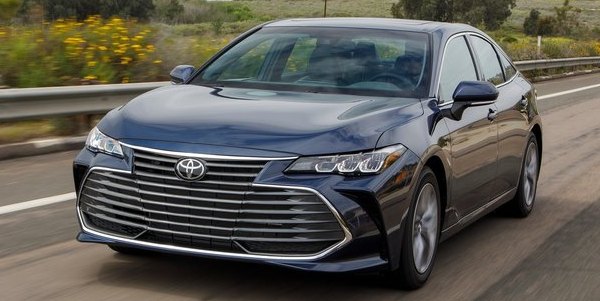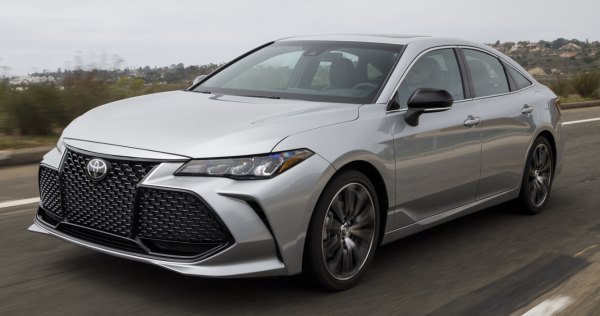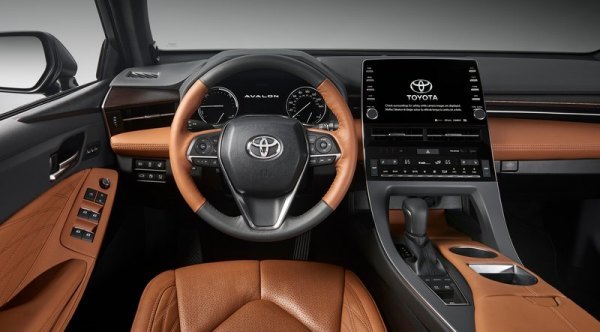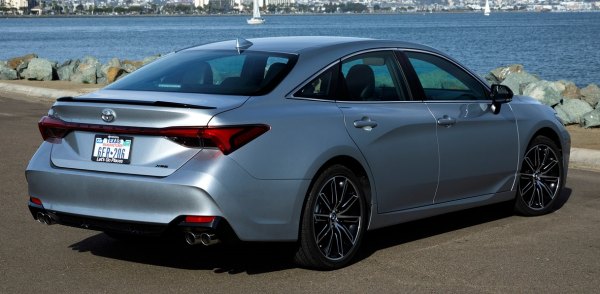Published
on 7
May 2018
|
All rights reserved.
|
|
|

|
|
If
a bit of sporty flavour cannot win, what about a big chunk of sporty
flavour?
|
|
Large
family sedan is a breed surviving in only North America. Its buyers are
usually old people born in the baby boom just after WWII. They prefer
conventional sedans to hatchbacks or crossovers, appreciate comfort
over sportiness, chase ease of use instead of fancy technologies, and
want
to spend their lifetime savings cautiously. Buick and Lincoln rely
heavily on these customers, but virtually every brand offers such a
car, such as Chevrolet Impala, Ford Taurus, Nissan Maxima and Toyota
Avalon.
Toyota Avalon has been there since 1994. It has always been built in
Toyota’s plant in Kentucky, USA, alongside its platform donor, Camry.
In its hey days it could sell 100,000 cars a year, but like everybody
else in the class, its sales have been sliding gradually during the
past decade as baby boomers are getting too old to buy new cars. Toyota
realized the problem long ago. In the last generation Avalon, it
deliberately made the car look sharper and drive sportier, hoping to
lower the average age of its buyers from 64 to the low 50s. 6 years
have gone, what is the outcome? Disappointingly, the average buyers are
still 64
years old, and the Avalon’s annual sales dropped from its peak of
71,000 to 33,000 cars last year. The reform failed.
 |
|
The
grille is large enough to cool a pair of Corvette ZR1 engines...
|
|
However, the Avalon is not going to surrender yet. If a bit of sporty
flavour cannot win, what about a big chunk of sporty flavour? Toyota’s
new family design language emphasizes a huge radiator grille at the
nose. The new Avalon has an even more aggressive interpretation.
Basically the entire front end bar the slim LED headlights is occupied
by the vast grille. I suppose it is large enough to cool at least a
pair of Corvette ZR1 engines and their 26 radiators combined, no
kidding! There are actually two different designs for the grille. On
lesser Avalons, the grille is surrounded by chrome and fitted with
horizontal slats. On sportier models, the surround is gloss-black and
the grille elements are honeycomb mesh. Both look seriously over the
top, and they should cause doubts about the taste of their owners.
After decades of boring design, the pendulum effect shown in Toyota
design is astonishing.
Otherwise, the Avalon is more pleasing to look than the last one. Its
proportion is sleeker, with a faster C-pillar and a lower waistline.
The roof is set 25mm lower while both length and width are marginally
increased. The wheelbase has been stretched by 50mm to 2870mm,
exceeding Camry by 45mm. The car shares the TNGA platform with Camry
and Prius, including the suspension of MacPherson struts up front and
multi-link at the rear (though Toyota misleadingly calls it
double-wishbone on those cars). Handling and ride are improved by a
number of measures, including more use of high-strength steel, a lower
center of gravity, wider tracks and the multi-link suspension. Oh yes,
AVS adaptive dampers are offered for the first time, albeit only on the
range-topping trim.

|
|
The
infotainment screen is best to display ski jump...
|
|
The interior is also more interesting to look and better finished. It
is spacious. The rear seat is a good place for tall passengers to
stretch their legs as it offers 60mm more legroom than Camry. The low
cowl and the resultant low dash enables an airy ambience. The dashboard
design is stylish, if a bit gimmicky, thanks to a curvy center console
that is probably inspired by the ramp of ski jumping. It houses a
9-inch infotainment touchscreen whose clarity, response and software
are all decent, although Android Auto is strangely missing here. The
use of soft-touch plastics is expanded from the dash top to lower
places that you may touch regularly. In more premium trims you can have
Yamaha real wood inserts, brown leather trims and piano black plastic
finishing as well, so it feels higher quality than most competitors,
but not good enough to challenge premium brands, of course.
Two power units are offered and, predictably, both are shared with
Camry. The conventional choice is the 3.5-liter V6 with codename
2GR-FKS. Compared with the old V6 its output is lifted by 31hp and
19lbft to 301hp and 267lbft, thanks in part to a higher compression
ratio as well as D-4S direct and port injection. By utilizing variable
cam phasing, it is now capable to run in Atkinson cycle under part load
to save fuel. In addition to a new 8-speed automatic transmission, both
acceleration and cruising economy are improved slightly. On top trim,
the V6 is mated with a sport exhaust and a sound synthesizer that plays
fake noise through speakers. You can forget that though, as the Avalon
is more about comfortable cruising than driving excitement. Its
front-wheel-drive chassis, while handles day to day work flawlessly, is
not designed for abuse. The front wheels struggle for traction under
hard throttle, and understeer happens sooner than a proper rear-drive
machine. Its steering is deliberately tuned heavier, especially in
sport mode, but that does not bring any more directness or feel to
inspire the driver.
 |
|
It
is better to stick with less aggressive trims and enjoy the suppler
ride and quieter cabin, which is what the car excels.
|
|
In fact, on sportier trims the 19-inch wheels rolling on low-profile
tires are proved to deliver too much road noise and harshness on small
imperfections for a large family car like this. The stiffer springs and
anti-roll bars they employ control the body motions better, but the
tradeoff in ride quality is not worthwhile. It is better to stick with
less aggressive trims and enjoy the suppler ride and quieter cabin,
which is what the car excels.
Another power option is Hybrid, combining the new Dynamic Force
2.5-liter D-4S Atkinson-cycle four-banger with a propulsion motor and a
starter generator. It produces 215hp combined and should be good enough
for 0-60 in 8 seconds. You buy this one for economy reasons, of course,
as it delivers 44mpg in city and 43mpg on highway, a vast improvement
from the V6’s 22/32mpg. The Hybrid costs $1000 more to purchase than
the V6, but you will recoup the cost quickly. By repositioning the
smaller NiMH battery pack from the boot to under the rear seat, it does
not rob any luggage space.
Unfortunately, despite the overly aggressive styling, the new Avalon
still feels more Camry-plus than BMW-minus. While Kia manages to break
the mold with Stinger, the Avalon has nowhere to go as it is sandwiched
by the Camry and Lexus ES in a tight breathing space. The market for
front-wheel-drive, non-premium large sedans might never extinct, but
not large enough to accommodate the Camry, Avalon and ES
simultaneously, especially when you insist to have all of them built on
the same platform.
|
Verdict:    |
|